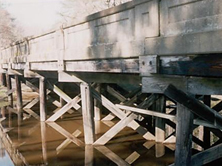 The no longer standing Kirby’s Creek Bridge (Northampton County Bridge 77) north of Conway, built in 1935, with timber stringers and substructure and state-standard reinforced concrete railings (source: NCDOT bridge inspection files).
The no longer standing Kirby’s Creek Bridge (Northampton County Bridge 77) north of Conway, built in 1935, with timber stringers and substructure and state-standard reinforced concrete railings (source: NCDOT bridge inspection files). Timber stringer bridges are simply a series of parallel wooden beams or logs carrying a deck. They have been used since the earliest days of settlement in North Carolina.
Timber stringer bridges have the advantage of using an abundant natural material, but are limited in span length (about 25 feet maximum) and deteriorate rapidly unless the wood is treated. Untreated wood generally has a lifespan of 10 years in North Carolina's climate. The most common treatment since about 1900 has been creosote, which extends the life of the wood on average to between 25 and 35 years, although some bridges have been known to last considerably longer.
In the 1920s the State Highway Department developed standard plans and specifications for timber stringer bridges, ensuring uniformity of design and economical use of materials by contractors and maintenance crews across the state.
The earliest surviving examples of timber stringer highway bridges are of the standard design adopted in June 1928 (Standard 600-C—Standard Creosoted Wood Superstructure with Reinforced Concrete Floor and Rails), which introduced a reinforced concrete deck and railings. It offered greater permanence than wood plank, as well as capacity for two 15-ton trucks.
Later plans were based on this successful standard, with variations for different span lengths, roadway widths, live loads, and the substitution of other standard railings.
According to the Historic Bridge Inventory, more than 570 timber stringer bridges have pre-1961 dates of construction. Most have very little, if any, original fabric, because individual members are replaced when they deteriorate as part of routine maintenance.
Today, timber stringer bridges remain one of the most common bridge types built on secondary roads. These bridges continue a long-lived technology but are composed of modern replacement material.